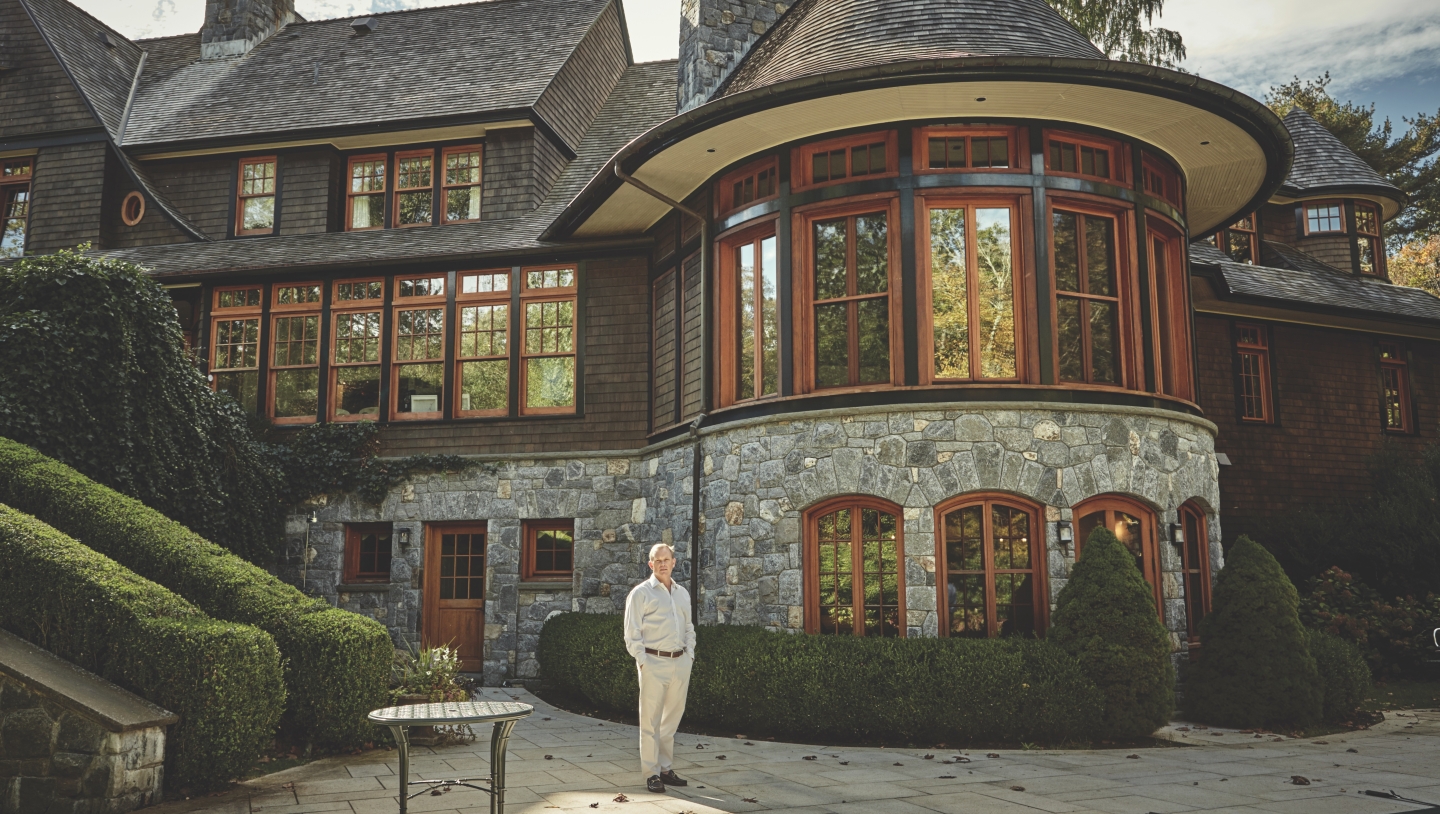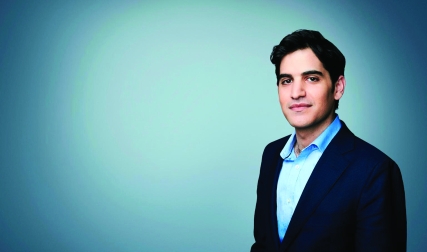It started with the OxyContin he was prescribed following an appendectomy in 2003. The opioid painkiller gave Trey Laird such a feel-good high that he soon became addicted. He “doctor-shopped” at first, complaining of back pain to multiple providers and getting prescriptions he’d fill at different pharmacies. Eventually he needed so many pills—50 to 60 a day—he was buying in bulk from an unscrupulous pharma rep who sold the drug out of the trunk of his car. Laird was also a heavy drinker, and his doctor told him his liver enzymes were rising to dangerous levels. “He said I was substantially shortening my life expectancy,” says Laird. “I just ignored the warnings. I didn’t think I was hurting anyone but myself.”
One groggy morning on his train commute to Manhattan in the summer of 2008, Laird popped his usual five or six pills and looked out the window at the world passing by. “I suddenly had this image of my daughter, who was 8 at the time,” he says. “I pictured her in her 20s, talking to her friends and saying she never really got to know her dad because he died when she was so young.”
To detox from his five-year addiction, Laird, an equity trader on Wall Street at the time, checked himself into Silver Hill, a nationally renowned psychiatric hospital in New Canaan, Connecticut. There he learned most addicts go back to their old habits shortly after rehab, but those who stay clean past the 90-day point have a good chance at long-term recovery. His counselor suggested he stay at a sober-living facility, but the options in and around New York City were limited. Most were more like overcrowded halfway houses. Laird knew this was not the sort of environment that would help keep him sober. “When you have a home, family, and good job, and then you’re sharing a room with a 20-year-old heroin addict who’s never had a bank account, you think, ‘Well, I don’t look like him, so my problem can’t be that bad,’ ” he says.
With his marriage heading toward divorce—due in great part to his addiction issues—Laird rented a home a half mile from Silver Hill. “Staying super close to where I had treatment made me feel safer,” he says. “It was such a dark and ugly time for me. I felt like the world was ending, but I went to a bunch of meetings and did everything they told me. I made it. I got through that ‘maybe I will, maybe I won’t’ phase. At day 90 I felt so much better on the inside and saw a path forward.”
Eleven years after that life-changing decision to get help, Laird, 49, now makes the transition from rehab to real life easier for other addicts like him. In 2016 he opened the Lighthouse, a sober-living home for men with means who want to keep their jobs and stay close to their families but need more strength in their sobriety before returning home. “It’s about being outside the bubble of treatment, but still in an accountable environment,” says Laird. “There’s so much focus on rehab, but not on what happens next.”
If the typical sober-living facility is like a Motel 6, the Lighthouse is the Ritz. “Our guests enjoy fellowship, the highest level of personalized care, beautiful furnishings, privacy, and discreet sobriety support,” the Lighthouse website boasts. “The minute you enter the front door, you’ll feel the serenity embrace you. Inside, you’ll find all of the comforts of home in a well-appointed residence with a modern interior decor and luxurious furnishings. Outside, the stately stone patio, gardens, and wooded property provide a tranquil place to relax in nature.”
A stay at the Lighthouse averages around $15,000 per month and is not covered by insurance.
The private home is a 10,000-square-foot, $2.3-million brick colonial nestled on four wooded acres in the affluent town of New Canaan. It has all the amenities of a posh retreat: a gym, movie theater, heated pool, and stone gazebo with an outdoor kitchen and fireplace. (There’s also a wine cellar, but it’s not going to be stocked any time soon. “Yeah, we need to figure out what to do with that space,” says Laird.)
All this luxury comes at a cost. A stay at the Lighthouse averages around $15,000 per month and is not covered by insurance. For those who can afford it, being in plush surroundings while going through a bleak time can be restorative.
“People who won’t go to treatment unless it looks like this often get bashed,” says Laird. “Like, ‘Why should it matter what the thread count is on your linens?’ But if that’s the difference between someone staying sober and not staying sober, then great, we will have the good linens.”
The level of attentiveness is five-star, too. A personal sobriety coach is assigned to each resident for one-on-one support. Together, the resident and coach design a tailored recovery plan that includes daily goals and coping strategies. Lighthouse coaches are also available to assist with résumé writing and professional networking, and they act as liaisons with family members, lawyers, and therapists, if needed. Recovery transportation services are also offered through the Lighthouse, and if a resident has an upcoming business trip or a family function or he’s worried about any situation that could trigger a relapse, he can arrange to have a sober companion accompany him. “We let our guys know from very early on that recovery is a team sport,” says Laird. “Someone always has your back.”
Aside from a Sunday night meeting, there is no mandatory group time. Residents are free to be on their own as much or as little as they’d like. But a natural bond quickly forms. Because the men are often in similar circumstances—a typical resident, says Laird, is in his early 40s, married with children, and has a successful career—they are more likely to open up with each other. A support system of peers can help enormously with recovery. The kinship is especially evident in the evenings. Over dinner prepared each day by an in-house chef, “the guys really share what they’re struggling with,” says Laird. “That’s when the magic happens.”
Much about the Lighthouse makes it feel like home, but before kicking off their shoes, residents must agree to rules, such as a 10 p.m. curfew, making their beds each morning, and committing to a recovery program such as Alcoholics Anonymous. There is a zero-tolerance policy on drugs and alcohol. Medications are locked in a safe. Rooms can be searched at any time and urine samples requested without warning.
Relapses are uncommon. When they occur, the resident must leave the house for a supervised detox period of at least 48 hours. “We don’t want to be punitive or shame anyone, but we do need to protect this environment,” says Laird. “We are big on second chances, as long as there is a change in attitude, and we believe someone is learning from their mistakes.”
All residents, regardless of whether they are recovering from a drug or an alcohol addiction, must keep a professional-grade breathalyzer, a Soberlink, with them at all times. They must do four blood-alcohol checks per day, and the results are automatically texted to Laird and his team. With facial recognition technology and tamper-detection sensors, this virtual tether keeps guests in check even when they’re miles away.
Not everyone was happy when the Lighthouse opened, no matter how wealthy the clientele. Neighbors filed complaints with the town, stating concerns about potential property devaluation and the discomfort they felt about tenants frequently moving in and out. But the town rebuffed them—federal housing law prohibits discrimination against people with disabilities, including those recovering from drug and alcohol addictions.
“High-quality, sober-living houses are a relatively new phenomenon,” says Dr. Andrew Gerber, president and medical director of Silver Hill, where many Lighthouse residents have previously been treated. “And there’s definitely a ‘not in my backyard’ fear among neighbors, based on the stigma that we should be afraid of people with vulnerabilities such as mental illness. But as that stigma lifts there’s an increased openness about the need for places such as the Lighthouse, where people can put their lives back together in a supportive environment.”
For Mike Holland, who was raised in New Canaan and lives in town with his family, there is no question the Lighthouse is a valuable community asset. On the afternoon of December 2, 2017, the Harvard grad and Bloomberg senior credit analyst picked up Christmas wreaths to bring home. Intoxicated, he swerved his Jeep and crashed into a utility pole. It was not the first time Holland, 37, had appeared in the police blotter. The incident led to his fifth arrest and third time in rehab.
This time, sobriety stuck. Holland hasn’t had a drink since that day and credits his time at the Lighthouse for helping turn his life around. While men typically move in for about four months, Holland, who had been drinking since he was a young teen, stayed for 10 months before he felt secure enough to return home. “For headstrong, ego-driven men, it takes a lot of time to accept help. You think it’s a sign of weakness,” says Holland. “But living with this group of like-minded individuals with the same malady, I started to finally establish a pattern of honesty and openness. I don’t bury stuff anymore. I’m okay in my own skin. I don’t fret about the future, I’m not pissed off about the past. I owe so much to Trey for that.”

Holland now acts as a mentor to newer members of the Lighthouse family and spends a couple of evenings a week there. He also leads a weekly meditation and mindfulness group at Silver Hill and attends and leads recovery meetings in Manhattan and around Connecticut’s Fairfield County. “It’s great to be able to show people that sobriety doesn’t mean life is over,” says Holland. “It makes life amazing.”
One of Laird’s goals when planning the Lighthouse was that it become a permanent place of belonging for everyone who walks through the doors. He encourages former residents such as Holland to drop by anytime. Alumni receive frequent invitations to Lighthouse events such as barbeques, ski trips, beach outings, and baseball games, and a surfing trip to Costa Rica is planned for next winter. “You know that bond between Dartmouth grads? I get to see our alumni here develop that same loyalty,” says Laird. “The most important tool you have in recovery is to feed off the strength of those that came before you.”
Plans are now underway for a Lighthouse for women in the New Canaan area (most sober-living homes are gender-specific). Laird is also working to open a location in Manhattan and to expand the Recovery 365 program, which offers monitoring and coaching for Lighthouse graduates as well as those who go directly home from a treatment program. “The ideal scenario is that the Lighthouse becomes the brand leader in recovery services,” says Laird.
Chief financial officer Heidi Smith ’93 is raising capital to fund the expansion. She has a background in private equity and has known Laird since their Hanover days. She smiles when she says that in addition to Laird and herself, most of the Lighthouse investors are also Dartmouth alums: Chris Downie ’91, Rob Ryan ’92, Dennis Durkin ’93, Buckley Ratchford ’93, and Steve Rodgers ’93. Another alum who wishes to remain anonymous funded the purchase of a new house. “It goes right back to that Dartmouth connection,” says Smith. “We wouldn’t be here without it.”
Laird, who grew up in New Canaan and New York City, was on the swim team at Dartmouth and majored in government. He was vice president of Alpha Delta and rarely missed a party. He enjoyed fraternity life and made a number of close friends, but he says he’d like to see colleges offer students more social spaces that don’t involve alcohol. “Many studies show that the longer people wait to drink, the better,” he says. “And you definitely don’t need to drink to be social.”
Laird’s daughter Brooke—that little 8-year-old who inspired him to get sober—is a 19-year-old sophomore at Middlebury. She and her brother, Teddy, 16, have a father in a much better place than he was when they were little. Not only is Laird healthy, he’s the happiest he’s ever been. Remarried in 2014, he’s now a dad to two more children: Tucker, 3, and Madeline, who was born in June.
Laird has also found professional fulfillment. Even though he’s making a fraction of what he did during two decades in finance, he says steering recovering addicts toward a beacon of hope is far more rewarding. “I’ve never worked harder for less money in my life,” he says. “But today I define success much differently. The way I compute my earnings now is by how many people I can help.”
Jennifer Wulff is a DAM contributing editor. She lives in Wilton, Connecticut.




